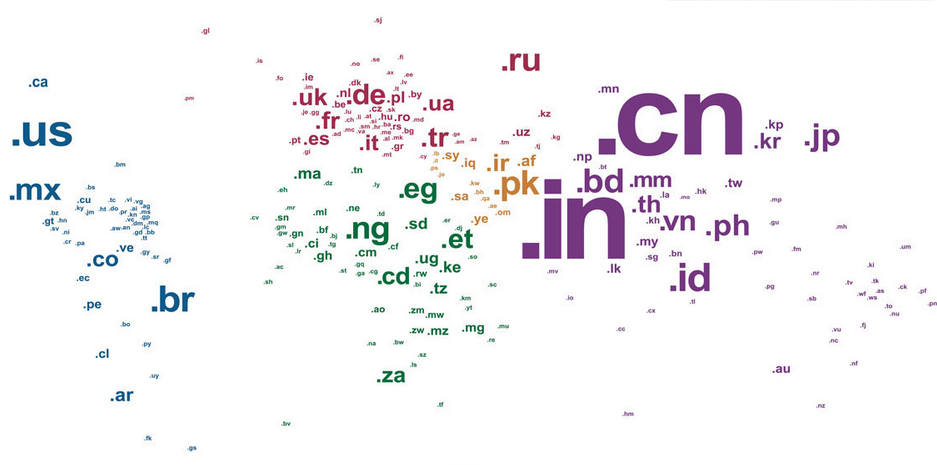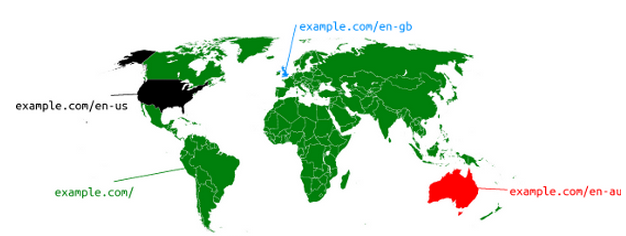Multilingual SEO Ultimate Guide
 E-commerce opens up opportunities to enlarge the scope of your enterprise to keep up with the times of the global economy. If you take a look at an international market, you will notice that outside of your country there are millions of people that could easily become your own customers. All you have to do is to let them purchase your goods and services as easy as they can do it through their local websites. It is time to adjust your website for an international consumer and to become a part of a really competitive market.
E-commerce opens up opportunities to enlarge the scope of your enterprise to keep up with the times of the global economy. If you take a look at an international market, you will notice that outside of your country there are millions of people that could easily become your own customers. All you have to do is to let them purchase your goods and services as easy as they can do it through their local websites. It is time to adjust your website for an international consumer and to become a part of a really competitive market.
For those of you who would like to get the guaranteed search engine optimization for your website there is a safe strategy that will become handy if you’re aiming at an international audience. The matter concerns multilingual SEO which allows you to take a firmer grip of both English-language and foreign-language searchers. The strategy includes writing, designing and ranking a website to make its content equally accessible and user-friendly in multiple countries. Here’s our useful and rather profound insight into multilingual SEO strategy and the ways to adjust it to your website.

Table of contents
Decide on your main goals
Before you start, think of the best ways to approach an international audience. It is essential to evaluate your powers objectively, as multilingual SEO strategy often becomes too difficult to achieve without proper resources and knowledge.
Local search engine registration
Although Google is the most popular search engine in the world, there are countries that have their own priorities as to the Internet search. Because national search engine alternatives are often more flexible in offering local commercial sources, you should be able to integrate into the engines of other countries. Thus, China prefers using Baidu search engine, while Czech Republic has its own Sezam. On the other hand, Google’s priority lies in its TLD (top-level domain) support. Accordingly, it’s better to register on several primary search engines to provide better ranking of your website in other countries.

Weigh all cons and pros
Depending on how many countries you want to involve in your multilingual SEO strategy, there are several issues to consider:
- your budget;
- the type of your business;
- the willingness to become a part of a global market;
- a possibility to open local offices in the countries you choose for your multilingual SEO;
- having bilingual custom service representatives/professional translators for a high class content development ;
- the willingness to employ staff specialized in marketing for each preferred country (in accordance with its cultural peculiarities);
- having a good tech support team for managing your website and making it available for a foreign searcher;
If you cannot decide what countries to concentrate on, use Google’s analytics tool to check how many international users are active on your website. It will be clear then whether you should try your hand at international search engine optimization or not. After you decide on the countries, see what languages are commonly used there. As a result, you will get more or less clear idea of how to prepare your website for further localization.
Choose the best website architecture
There are three main ways to localize your website for different languages: individual TLDs, subdomains, and subfolders. Each of them has its own advantages and disadvantages as for their functionality, and this must be taken into consideration beforehand.
ccTLDs (example.au, example.co.uk) provide separate country codes, which means that for each country you target there must be an individual website in the appropriate language. TLDs are very effective in targeting geographic locations by the search engines, which means they don’t require specific server location that much. However, it will take a lot of time and investments to make all of the sites equally optimized. It’s also possible that you will need a different SEO strategy for each individual domain.

Subdomains (de.example.com, ca.example.com) are more flexible and can exist individually within one generic TLD. You can adjust them to specify languages or locations of the searchers so that they could go on the right page right away. The good thing about subdomains is that they are more easily set up and available for local hosting. The bad thing is that here you will also have to apply different SEO strategies remembering that search engine geolocation targeting with subdomains is not as effective as it can be with an individual TLD. Moreover, in the search results list, searchers will likely choose those websites that have their own country’s TLD.

Subfolders (example.com/ca/, example.com/ru/) are capable of passing authority across the domain, which makes it easier for a user to switch between site sections. They are also easy to set up and can be geo-targeted individually with the help of Webmaster Tools. Because it doesn’t require a new domain, the costs for creating a subcategory are sufficiently reduced. The weak side of subfolders is their poor geo-detection sensitivity, which means that foreign users’ location won’t be always correctly identified.
Steps to take
To optimize ranking of your website in other countries you need to be ready with the following:
- If you don’t have enough resources for managing individual language websites you can basically create subfolders for each language you include your content in. Otherwise, new sites with individual domain are always welcome.
- If your business is already localized in different countries, it is important to include individual phone numbers and addresses on every language subfolder so that it could be identified by search engines.
- Although cloud hosting is more popular nowadays, a server location may not be that important. However, if you still have a chance to locate your server in the countries you’re aiming at, don’t lose it.
- Pay attention to the Meta Tag placement on every page of your website.
- Although duplicate content by itself is considered to be lame for SEO in general, duplicating content to make it look unique for a specific audience is quite a good challenge. For instance, having separate view-pages for UK and US citizens could significantly increase your web-site’s ranking in the both countries, as it means that you take into consideration not only the language people speak but also their cultural backgrounds.
- To make the usage of duplicate content even more justified, you can work on individual design for UK and US pages – it might enhance the general usability of the site. Moreover, why not creating an original design for every language subfolder?
- If you present several page versions for English- or Spanish-speaking users, you should take into account slight differences in the vocabulary use to decide on the more appropriate key-words for a specific audience.
- You should also utilize individual XML sitemaps and attach them to the search engines. It’s better even to register each sitemap as a separate site.
- Using subfolders is also efficient when you target users in a specific country with the help of Google Webmaster Tools. You can adjust it under ‘Configuration’ in GWT Settings. However, it’s only applicable to TLD websites; country-coded domains like co.uk, de and so on in the site address already suggest the particular market you’re targeting.
- Remember about proper abbreviation for each language subfolder: example.com/us/, example.com/ca/ etc.
- Use local links for every language page, as it’s more valuable in terms of local market efficiency.
- Be careful with the word choice and images on pages in foreign languages that you’re not confident of.
- If you’re not satisfied with the results of your strategy, the problem can be that you need to update the content and key-words of your website to satisfy up-to-date tendencies on the local market.
Technical Issues: “x-default hreflang”
Multilingual SEO, among other things, requires application of up-to-date annotations to properly redirect users from the home-page to the localized versions of the website depending on their language or geolocation. At the moment, the most effective and stable annotation for specifying different language pages is rel-alternate-hreflang which is supported by both Google and Yandex.
If you use subfolders for displaying site pages in different languages, than it’s quite cool that you have sitemaps to let users choose their country before actually getting to your content – this friendly gesture is going to attract even more attention afterwards. That’s why the homepage is the best place for putting your country selector on. Assuming that the homepage is actually the default page, you can annotate your subfolders like the following:
<link rel=”alternate” href=”http://example.com/en-gb” hreflang=”en-gb” />
<link rel=”alternate” href=”http://example.com/en-us” hreflang=”en-us” />
<link rel=”alternate” href=”http://example.com/en-au” hreflang=”en-au” />
The default page will then look like this:
<link rel=”alternate” href=”http://example.com/” hreflang=”x-default” />

The x-default hreflang attribute value informs that the current page will be displayed each time no other particular sub-page satisfies the requirements. This page sets no specific language or location, so the user will instantly get to the original main page. Thus, it can be applied to English-speaking searchers on google.ca or French-speaking searchers all over the world.
User agent/User IP detection
User agent detection enables to determine the device a person is using to browse your website. Having received this information, you can adjust the content view mode in the most appropriate way. Detecting users’ location through their IP address is also a good way to provide them with the content which is relevant for that specific region. When using these two techniques at the same time there is a chance to get more accurate geolocation data, especially when you deal with subdirectories.
Redirection type is also closely connected with user IP and agent detection. Thus, you can use HTTP redirection to adjust your website URL for a specific device. In this case it’s important to use rel=”alternate” tags in the link or add specific URL in the sitemap. Otherwise, you can use JavaScript redirection which, however, takes a bit more time because it has to first download the page, analyze its content and only then to execute the algorithm.
How to make foreign language pages user-friendly

The most important aim in multilingual SEO is to understand the needs of your foreign clients. It’s necessary to provide them with a positive experience of the website browsing, so try to keep them away from an unfamiliar language. Good translation also means a lot, but it concerns not only the content itself, but also options and the rest of your menu part. Providing a comment translation may seem too much, but it can become a crucial factor for a customer’s decision as for your liability. It’s also worth introducing appropriate currency on every specific language/country page to foresee all the potential requirements of your customers. Lastly, creating individual customer support service section will make your international audience feel home-like and secure.
The key to successful multilingual content marketing
Once you’ve managed with the target language pages, the focus shifts then to sustaining them on the appropriate level to gain more pageviews and orders. You will need the following:
- Create a blog that could be available in all the target languages and update it as often as possible.
- Add catchy infographics and images to attract searchers’ attention.
- Don’t forget about the cultural differences between you and your foreign customers and be able to meet their needs by, for instance, applying specific cultural elements into translated versions of your content.
- It’s also useful to interact with other bloggers that are representatives of the target languages you chose for your website. Join your efforts in the common aim of attracting the audience of the target region.
- Provide all the foreign language pages with external links to the same language/country websites.
- Keep an eye on achievements of your colleagues in the sphere of search engine optimizations by analyzing their websites and user activity. The easiest way to do it is through moz.com and ahrefs.
- Create a company’s public page in social media and regularly post the most popular content there. Paid ads will also contribute to the size of your audience.
- Never cease to long for a quality: the better the content, the more valuable you become on the global market.









